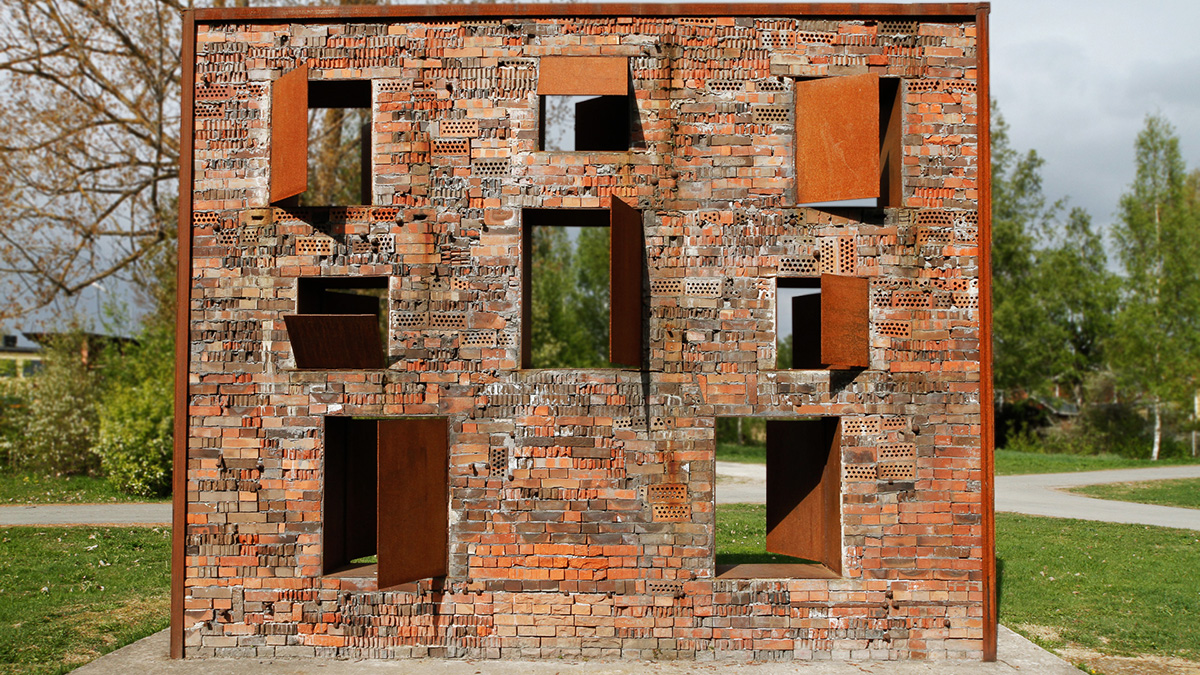Backdoor
A free-standing square brick wall, perhaps one meter thick and four meters high, stands on its own on a concrete slab on the grass near a couple of walkways. The brown and orange rough bricks are bricked holes for noise, alternately with the long side or the short side facing the viewer.
Brown wooden planks frame the outer sides and crest of the brick wall. The wall contains eight asymmetrically placed window openings in different sizes. The shutters consist of thin sheets of steel. All doors are open on either side of the wall so that it is possible to look at nature straight through it.

Have you visited any of the old ironworks in Närke or Bergslagen and seen the buildings and environments that the industries left behind? Doesn’t James Bates’s Backdoor look almost like a relic from some ancient cultural site?
The work was created for the place on which it stands. The brick and the rough steel seem to be relatives of the fencing and abandoned train tracks of the surrounding industrial landscape. But unlike these, Bate’s double-sided façade has never had any practical function. Instead, it invites viewers to observe and contemplate the appearance, textures and composition of the assembled building materials.
Brick façades are often characterized by uniform repetition, but here, different sides of the brick are turned toward the observer. Some are lying with their tops facing out so that we can see the patterns of holes that are usually hidden in the mortar. The artist explains that the cavities and the design of the entire wall was a way to create a changing play of light and shadow. How are the shadows from the window shutters falling now? If you come back another time, you’ll see that they stand out in a different way against the brick.
Backdoor is located at a pathway intersection with one side facing the road. Bates didn’t want the other side of the sculpture to be the back side, however, but rather designed both sides with the same care. And that was lucky, because people have not kept to the straight lines of the city plan but have instead taken shortcuts and approached the sculpture from the “back side” so many times that a diagonal strip has been worn in the grass between the two paved walkways.
Konstverk: Backdoor
Konstnär: James Bates
År: 2001
Material: Danish moulded brick, mortar, corten steel
Placering: Lilla Å sculpture riverwalk, in Holmen industrial area
Ägare: Örebro Municipality
Konstverkets position på karta
Publicerad:
Tack för ditt svar!
Berätta gärna vad vi kan göra bättre på den här sidan för att förbättra webbplatsen! Vi har ingen möjlighet att svara, men dina synpunkter är värdefulla för oss. Tänk på att inte skicka in personuppgifter. Om du vill ha svar på en fråga kan du istället använda formuläret ”Lämna en synpunkt”.
Om du ändå skickar in personuppgifter via detta formulär hanteras uppgifterna av Kommunstyrelsen och kan eventuellt lämnas vidare till annan verksamhet inom Örebro kommun i syfte att förbättra vår service.
Här hittar du mer information om hur vi hanterar personuppgifter.
Tack för ditt svar!
Du har nu hjälpt oss att förbättra orebro.se
